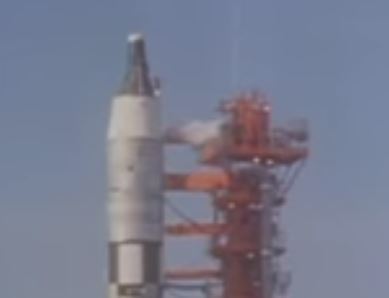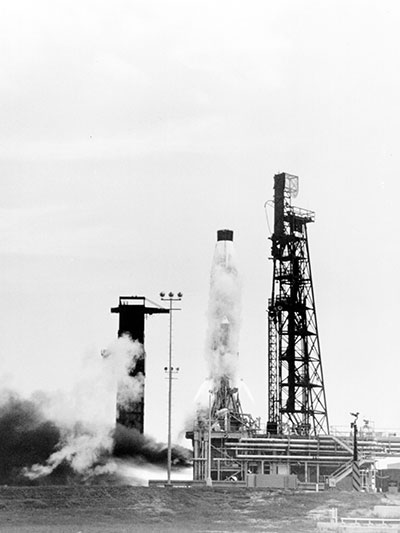|
Author
|
Topic: Gemini OAMS test during countdown
|
Fra Mauro
Member Posts: 1739
From: Bethpage, N.Y.
Registered: Jul 2002
|
 posted 09-02-2018 10:40 PM
posted 09-02-2018 10:40 PM
   
I was reading my Apogee books copy of the Gemini 12 mission report again, and I noticed on the countdown timeline there is listed an OAMS (Orbit Attitude and Maneuvering System) test at T-20 minutes. Was this done on all flights? It seems strange to me that this was done. |
David C
Member Posts: 1460
From: Lausanne
Registered: Apr 2012
|
 posted 09-03-2018 05:12 AM
posted 09-03-2018 05:12 AM
  
Yes it was. If you think of the analogy with airplane flying, seems like a good idea to test your controls before committing. Of course there were other considerations on later spacecraft. The Gemini III transcript (bottom of page 4, top of 5) is a good example. |
space1
Member Posts: 951
From: Danville, Ohio
Registered: Dec 2002
|
 posted 09-03-2018 06:30 AM
posted 09-03-2018 06:30 AM
   
Originally I thought these tests were started with Gemini IX as a result of the Gemini VIII thruster problem. But apparently they were done on all Gemini launches. However, in the case of Gemini III the Reentry Control System (RCS) thrusters were also tested. Normally the RCS would not be activated until shortly before reentry to ensure integrity of the system regarding pressure or propellant leaks. But with Gemini III being such a short mission it was safe to test these thrusters before launch. |
Headshot
Member Posts: 1348
From: Vancouver, WA, USA
Registered: Feb 2012
|
 posted 09-03-2018 08:39 AM
posted 09-03-2018 08:39 AM
   
I distinctly recall seeing the puffs of smoke around the Gemini spacecraft adapter section when the thrusters were being fired for this test during television coverage of several launches. If the wind was "strong," they dissipated very quickly and were hard to see. |
Fra Mauro
Member Posts: 1739
From: Bethpage, N.Y.
Registered: Jul 2002
|
 posted 09-04-2018 06:31 PM
posted 09-04-2018 06:31 PM
   
Thanks for the info. It's amazing how much more there is to learn about our past missions. I watched several Gemini launches as a boy but I certainly wasn't looking for an OAMS test. |
Space Cadet Carl
Member Posts: 305
From: Lake Orion, MI
Registered: Feb 2006
|
 posted 09-05-2018 10:52 AM
posted 09-05-2018 10:52 AM
   
Fascinating. I was fortunate to have a color console television to watch all the Gemini flights in '65 and '66. Don't recall seeing any thruster tests happening in the final minutes before launch, but I really wasn't looking for it either. |
LM-12
Member Posts: 4017
From: Ontario, Canada
Registered: Oct 2010
|
 posted 09-05-2018 12:01 PM
posted 09-05-2018 12:01 PM
  
Somewhat related: the RCS thrusters on the LM were tested (hot-fired) before lunar liftoff. The RCS test on Intrepid (Apollo 12) knocked over the S-band antenna that was deployed on the lunar surface.Similarly, the S-band antenna blew over on Apollo 14 after that RCS test.
|
ManInSpace
Member Posts: 303
From: Brooklin, Ontario Canada
Registered: Feb 2018
|
 posted 09-05-2018 03:27 PM
posted 09-05-2018 03:27 PM
  
Like many of you, I grew up in the Gemini/Apollo era; but was unaware of the pre-launch thruster tests.My thanks to all the posters on this issue and also to LM-12 for the RCS information, another procedure that I wasn't aware of. |
tlifan2
Member Posts: 65
From: Palm Coast, Florida
Registered: Feb 2014
|
 posted 09-05-2018 06:54 PM
posted 09-05-2018 06:54 PM
   
If you look at this video of Gemini V starting at 3:55, you can see what I think is the OAMS thruster testing. See if you agree. (Ignore the audio). |
moorouge
Member Posts: 2486
From: U.K.
Registered: Jul 2009
|
 posted 09-06-2018 12:17 AM
posted 09-06-2018 12:17 AM
   
Is this it -  |
space1
Member Posts: 951
From: Danville, Ohio
Registered: Dec 2002
|
 posted 09-06-2018 04:17 AM
posted 09-06-2018 04:17 AM
   
Yes. |
Fra Mauro
Member Posts: 1739
From: Bethpage, N.Y.
Registered: Jul 2002
|
 posted 09-06-2018 09:00 AM
posted 09-06-2018 09:00 AM
   
Thanks for the video. I do recall the testing of the LM's RCS on the moon. |
Headshot
Member Posts: 1348
From: Vancouver, WA, USA
Registered: Feb 2012
|
 posted 09-06-2018 10:02 AM
posted 09-06-2018 10:02 AM
   
That sure looks like the OAMS testing (if that is indeed what it is) that I recall, but in this case (Gemini V) it is much more visible than what I remember. I believe the visibility of the puffs depended on wind speed, lighting conditions and camera angle (having that red umbilical tower behind the puffs helped provide contrast). Good job in locating that video. |
LM-12
Member Posts: 4017
From: Ontario, Canada
Registered: Oct 2010
|
 posted 09-06-2018 11:12 AM
posted 09-06-2018 11:12 AM
  
Here is some 16mm footage taken of the LM liftoff on Apollo 14. Look closely at the first few seconds. In the first scene, you see the S-band antenna shadow. In the second scene, you don't. The RCS test must have taken place between the two scenes. Notice also how the flag has moved. |
LM-12
Member Posts: 4017
From: Ontario, Canada
Registered: Oct 2010
|
 posted 10-04-2018 11:00 PM
posted 10-04-2018 11:00 PM
  
There is this entry in Volume IV of "The Apollo Spacecraft - A Chronology" for October 28, 1968: MSC Apollo Spacecraft Program Office Manager George M. Low deleted the requirement for a short static-firing of the Apollo 8 service module reaction control system on the pad before launch (the so-called "burp" firing). He took this move in line with a recommendation from NASA Apollo Program Director Samuel C. Phillips and in light of the nominal performance of the RCS during the Apollo 7 flight. By thus eliminating the burp firings — and not allowing any contact of the system's hypergolic propellants — the spacecraft could be maintained in a loaded condition through the December and January launch windows and gain the maximum launch flexibility for the Apollo 8 flight. (Decisions not to static-fire the RCS systems on spacecraft following 103 had been made some time earlier.) |
LM-12
Member Posts: 4017
From: Ontario, Canada
Registered: Oct 2010
|
 posted 11-12-2018 02:41 PM
posted 11-12-2018 02:41 PM
  
The Apollo 7 Press Kit has a "spacecraft RCS static fire" test at T-20 minutes in the countdown events. From the PAO transcript: This is Apollo Saturn Launch Control at T-21 minutes and counting. T-21, at this time the commander of the Apollo 7 Spacecraft, Wally Schirra, has gone through a series of checks with the reaction control system on the Apollo 7 Spacecraft. We have a total of some 16 reaction control system engines on the service module of the Apollo 7. They're located in four quadrants around the service module and each of the engines is capable of generating some 100 lbs. of thrust. Astronaut Schirra fired these thrusters and the report from the Spacecraft Test Conductor is the static firing went very well. We actually did fire several of the thrusters during this test and the report was that the test went well. In the meantime we completed some final checks of the range safety destruct system aboard the Saturn lB launch vehicle. These are checks between the launch crew and the Air Force Eastern Test Range. Those checks also went very well, and the count is continuing. We have just passed the 20 minute mark. We are now at T-19 minutes, 54 seconds and counting. This is Launch Control. |
LM-12
Member Posts: 4017
From: Ontario, Canada
Registered: Oct 2010
|
 posted 11-10-2024 11:47 AM
posted 11-10-2024 11:47 AM
  
Photo S62-06634 has this caption:
Static test firing of the Mercury-Atlas 8 (MA-8) Atlas 113D during preflight verification of launch vehicle systems.  |
Jim Behling
Member Posts: 1949
From: Cape Canaveral, FL
Registered: Mar 2010
|
 posted 11-10-2024 06:37 PM
posted 11-10-2024 06:37 PM
   
quote:
Originally posted by LM-12:
Static test firing of the Mercury-Atlas 8 (MA-8) Atlas 113D
Booster static firings were a common practice and were not done during countdown, spacecraft very uncommon hence this thread. |
Captain Apollo
Member Posts: 367
From: UK
Registered: Jun 2004
|
 posted 11-12-2024 03:38 AM
posted 11-12-2024 03:38 AM
   
Is there video of the LM RCS test firing from the LRV for Apollos 15, 16 and 17? |













